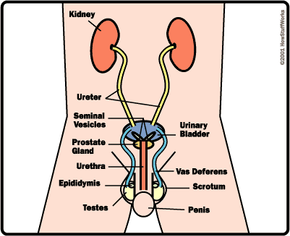Male Sex Organs
From the outside, the male has two visible sex organs, the testes (or testicles) and penis. The testes are the primary male sexual organs in that they make sperm and produce testosterone. The sperm is the male sex cell, or gamete, and each testicle produces more than 4 million new sperm per hour [source: Angier]. Testosterone is the hormone that causes male secondary sex characteristics such as facial and pubic hair, thickened vocal cords and developed muscles.
The testes are housed outside of the main part of the male's body, in a sac called the scrotum. This location is important because in order for the sperm to develop properly, they must be kept at a temperature about two degrees cooler than normal body temperature. It takes sperm about 4 to 6 weeks to mature, which they do as they travel from each testis to a coiled tube on the outer surface of each testis called the epididymis. Sperm, which are often compared to tadpoles in appearance, use their tails to travel, while the head contains the genetic material.
Advertisement
The penis is made of soft, spongy tissue that can expand or contract. When a man becomes sexually aroused, the penis becomes engorged with blood, causing the spongy tissues to stiffen and the penis to become erect. This erect state makes it easy to place the penis inside a woman's vagina during sexual intercourse. During sex, the male reproductive system is still at work, equipping the sperm with the assistance they will need to fertilize an egg. Find out more about this process on the next page.
